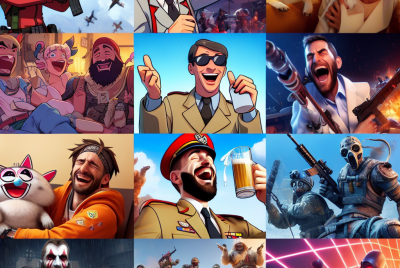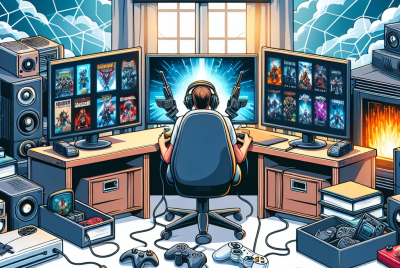Navigating the Challenges of Indie Game Development
In “Navigating the Challenges of Indie Game Development,” we dive into the unique hurdles faced by aspiring indie game developers. From securing funding to standing out in a saturated market, we explore the resilience and creativity required to bring a dream game to life. Our journey unveils the intricacies of managing a small team, balancing limited resources, and the relentless pursuit of innovation. Together, we will discover strategies and insights that empower indie developers to overcome these obstacles and build games that resonate with players worldwide. Have you ever dreamed of creating your own video game? Do you envision building fascinating worlds, crafting thrilling narratives, and developing captivating gameplay? While the allure of indie game development is undeniable, it’s a journey fraught with numerous challenges. Together, we will explore the intricacies and hurdles of the process, unveiling what it takes to bring an indie game from concept to reality.

Understanding Indie Game Development
Before we delve into the challenges, let’s clarify what indie game development entails. Independent (indie) game development refers to creating games without substantial financial backing from a large publisher. Often, these games are born out of passion projects by small teams or individuals.
The Indie Game Development Process
The development process typically follows several stages:
- Conceptualization: Formulating the game’s core idea and vision.
- Pre-production: Creating design documents, prototyping, and planning workflows.
- Development: Writing code, developing assets, and continuous testing.
- Alpha and Beta Testing: Identifying bugs and gathering feedback from a limited user base.
- Launch: Releasing the game to the public.
- Post-launch Support: Patching, updates, and player community engagement.
Each stage presents its unique set of challenges. Let’s break them down to understand better what we’re up against.
Financial Constraints
One of the most substantial hurdles for indie game developers is securing funds. Unlike large game studios, indie developers often rely on personal savings, crowdfunding, or small investments.
Bootstrapping
Many indie developers bootstrap, or self-fund, their projects. This approach can be extremely taxing due to the inherent financial risk. We might need to balance a full-time job or other responsibilities while pursuing our dream of game development.
Crowdfunding Platforms
Platforms like Kickstarter and Indiegogo can help finance our projects. However, not every campaign meets its funding goals. Successful crowdfunding relies heavily on a well-planned strategy and strong community engagement from the outset.
Grants and Competitions
Various grants and gaming competitions offer financial aid, but there’s intense competition for these limited resources. Crafting compelling applications and pitches can be a challenging task in itself.
Limited Resources and Workforce
Indie dev teams usually consist of a few individuals, often requiring members to wear multiple hats.
Multitasking
We might find ourselves juggling programming, art design, sound design, and marketing. This scope of work can be overwhelming and lead to a dilution of focus unless effectively managed.
Finding the Right Talent
Attracting skilled individuals willing to work for low or deferred pay can be difficult. Collaborating effectively in remote, often part-time schedules compounds this challenge.
Technical Challenges
Software and Tools
While open-source tools and affordable software have democratized game development, selecting and mastering the right tools remains a significant challenge. Each aspect of game development—coding, game engines, graphic design, sound production—requires specialized software and proficiency.
Platform Compatibility
Ensuring our game works seamlessly across multiple platforms (PC, consoles, mobile devices) adds another layer of complexity. Different platforms may require distinct coding standards, optimizing strategies, and testing methods.
Achieving Performance Optimization
Even with the right tools, ensuring our game runs efficiently on diverse hardware configurations is tough. Poor performance can alienate users and tank our game’s success.

Game Design and Innovation
Creating a compelling and engaging game is at the heart of our development journey.
Originality vs. Market Trends
Balancing originality with market appeal is a tightrope walk. While we aim to innovate and bring fresh ideas to the table, understanding what the market wants—what will sell—is crucial. This balance is often difficult to achieve.
Level Design and User Engagement
Crafting levels and gameplay mechanics that are not only engaging but also balanced and fair can be daunting. Detailed playtesting and iteration are essential, often revealing just how much work is needed to polish our game to perfection.
Marketing and Audience Building
Even if we develop a fantastic game, getting it noticed in a crowded market is one of the biggest challenges we’ll face.
Pre-launch Hype
Building excitement before launch requires strategic marketing. Engaging with our target audience through social media, game forums, and press outlets helps build anticipation. Press kits, teasers, and blog updates form part of our promotional strategy.
Post-launch Marketing
The marketing doesn’t stop at launch. Continuous engagement with the gaming community, updates, and solving any issues promptly play a massive role in our game’s long-term success.
Managing Player Feedback
Post-launch, player feedback is invaluable. Managing this feedback constructively, addressing common criticisms, and consistently improving our game is a significant but essential task.

Legal and Business Aspects
While creative elements might dominate our focus, legal and business factors are equally critical.
Intellectual Property (IP) Rights
Understanding IP rights is crucial to protect our game and story. We must ensure we own or have rights to every asset we use to prevent potential legal battles that can arise long after our game’s release.
Publishing Agreements
When entering into publishing agreements, reading the fine print is essential. Some publishers may demand significant control or revenue share, which might not always be in our best interest as indie developers.
Financial Planning and Management
Proper financial planning helps keep our project within budget. Accounting for every aspect, from software licenses to marketing costs, ensures we don’t run out of funds prematurely.
Community Building
Developing a supportive and engaged community can greatly influence our game’s success.
Online Presence
Building an online presence through developer blogs, forums, and social media helps establish a connection with our potential player base. Transparency in development and frequent updates can build trust and anticipation.
Player Involvement
Involving players in our development process through alpha and beta tests can provide invaluable insights. Engaging with our community and showing that we value their input can foster loyal supporters who advocate for our game.

Mental Health and Burnout
The stress of indie game development can take a toll on our mental health.
Work-Life Balance
Balancing the demands of game development with personal life is essential. While passion drives us, consistent overworking can lead to burnout.
Seeking Support
Knowing when to seek support—whether from teammates, family, or mental health professionals—is crucial for maintaining our well-being.
Celebrating Small Wins
Acknowledging and celebrating even minor achievements can keep our morale high. Game development is a marathon, not a sprint, and every step forward is progress worth recognizing.
External Competitions
The indie game market is flooded with numerous titles vying for attention.
Standing Out
Our game needs a unique selling proposition (USP) to stand out. Identifying what sets it apart—whether it’s a unique art style, innovative gameplay mechanics, or a compelling narrative—is key.
Pricing Strategy
Setting the right price is crucial. We must balance covering our costs and making our game accessible to a wide audience. Promotions and discounts can also be a powerful tool, but they must be strategically timed.
Longevity and Post-launch Strategy
Launching the game is just the beginning. Maintaining player interest post-launch ensures our game’s longevity.
Content Updates
Regular updates and new content keep players engaged. These updates can range from new levels, characters, and storylines to seasonal events and bug fixes.
Expanding the Universe
Expansions, spin-offs, or sequels can build on our game’s success. However, these projects should only be considered if we’re confident they add value and maintain our game’s quality and integrity.
Community Engagement
Regularly interacting with our player base, whether through forums, social media, or in-game events, fosters a strong community and keeps our players invested in the game.
Case Studies of Successful Indie Games
Let’s look at a few case studies of successful indie games to understand what worked for them and what we can learn.
| Game | Key Strategies | Lessons Learned |
|---|---|---|
| Celeste | Strong narrative, tight controls, community feedback | Importance of solid gameplay mechanics and story |
| Stardew Valley | Community engagement, regular updates, unique concept | Value of community and continuous development |
| Hollow Knight | Beautiful art, expansive gameplay, community support | Role of aesthetics and in-depth content |
Celeste
“Celeste” features a tight-knit platforming experience combined with a compelling narrative about mental health. The developers prioritized responsive controls and incorporated extensive community feedback, leading to a polished and acclaimed game.
Stardew Valley
“Stardew Valley” thrived on its unique concept of a farming simulation with RPG elements. Continuous community engagement and regular updates kept the game relevant and beloved by players for years.
Hollow Knight
“Hollow Knight” stood out with its stunning hand-drawn art and expansive, interconnected world. The game’s depth and the developers’ commitment to post-launch updates and community interaction contributed significantly to its success.
Summary and Conclusion
Navigating the challenges of indie game development is a complex and multifaceted journey. From financial constraints and limited resources to technical hurdles and marketing efforts, each stage demands careful planning and execution. However, our passion, perseverance, and adaptability can turn these challenges into stepping stones toward success.
While the path is far from easy, the satisfaction of creating something our own and seeing players enjoy our work makes the journey worthwhile. By understanding and preparing for the various challenges, we can improve our chances of making a mark in the ever-evolving landscape of indie game development. Together, we can turn our dreams into reality, one game at a time.




